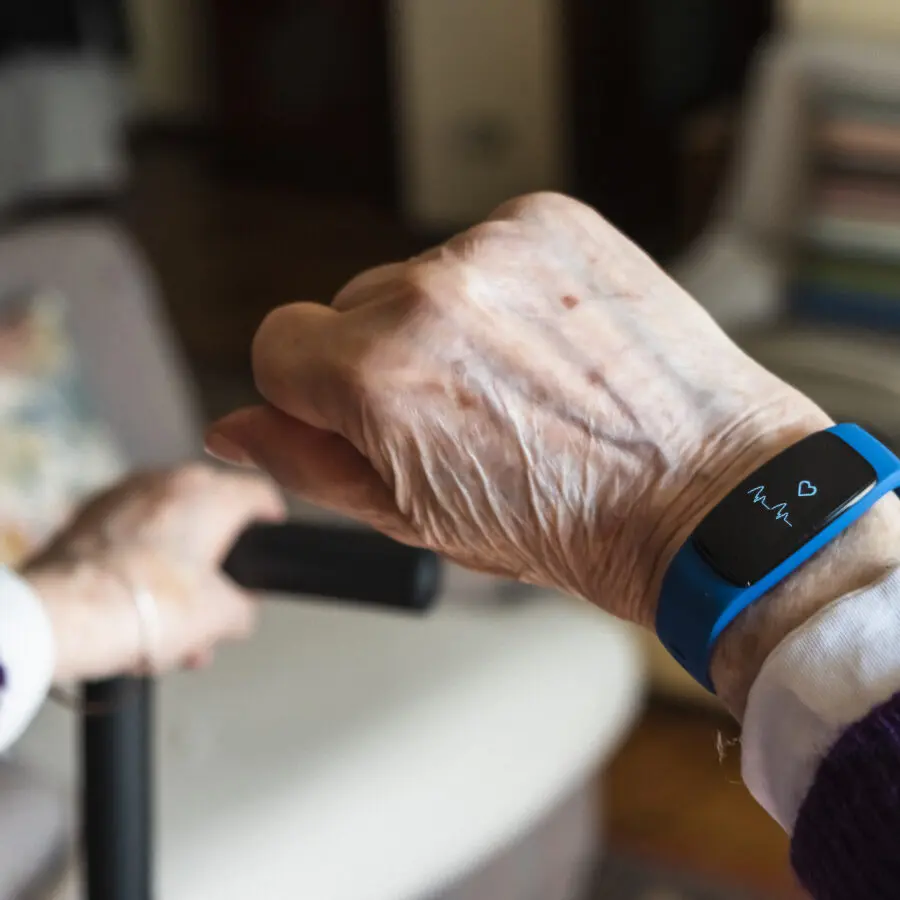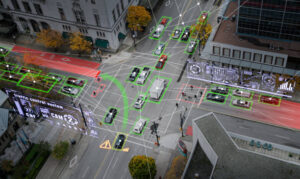Alzheimer’s disease is a progressive neurological disorder that affects memory, thinking, and behavior. It is the most common cause of dementia among older adults, leading to significant cognitive decline and loss of independence. Managing Alzheimer’s disease poses substantial challenges for both patients and caregivers, requiring constant monitoring and support.
Wearable IoT devices for Alzheimer’s patients offer innovative solutions to these challenges. These devices, including smartwatches and GPS trackers, provide continuous monitoring of patients’ health and location. They enhance safety, improve the quality of life, and offer peace of mind to caregivers by enabling real-time data collection and alerts.
The integration of wearable IoT devices for Alzheimer’s patients represents a significant advancement in healthcare technology, offering numerous potential benefits. This article explores the various ways these devices can aid in the care and management of Alzheimer’s patients, highlighting their importance in modern healthcare solutions.
In this article, we will delve into the potential benefits and applications of wearable IoT devices for Alzheimer’s patients, examining how they improve patient safety, provide real-time health data, and support caregivers in managing this challenging condition.
Understanding Alzheimer’s Disease
Alzheimer’s disease is a progressive neurodegenerative disorder characterized by the gradual loss of cognitive functions, including memory, reasoning, and the ability to perform daily activities. As the disease advances, patients experience severe memory impairment, confusion, mood swings, and difficulty communicating. This decline significantly affects their independence and quality of life.
For caregivers, managing Alzheimer’s patients is demanding and emotionally challenging. Caregivers often face stress, burnout, and physical exhaustion while providing constant supervision and support. The emotional toll of watching a loved one deteriorate can also lead to depression and anxiety.
Current Challenges in Managing Alzheimer’s Disease
Managing Alzheimer’s disease presents several challenges:
Continuous Monitoring: Alzheimer’s patients require round-the-clock monitoring to ensure their safety and well-being. This is particularly crucial for preventing wandering, a common behavior in Alzheimer’s patients that can lead to dangerous situations.
Medication Management: Ensuring that patients adhere to their medication schedules is vital for managing symptoms and slowing disease progression. However, memory loss and confusion often result in missed doses or incorrect medication usage.
Health Monitoring: Tracking vital signs, physical activity, and sleep patterns is essential for maintaining overall health. However, traditional methods of health monitoring are often inadequate for the constant supervision Alzheimer’s patients need.
Communication Barriers: As cognitive functions decline, patients may struggle to communicate effectively, making it difficult for caregivers to understand their needs and provide appropriate care.
Wearable IoT devices for Alzheimer’s patients can address many of these challenges, providing continuous monitoring, real-time health data, and improved communication methods to enhance care and safety.
How Wearable IoT Devices Work
Wearable IoT (Internet of Things) technology consists of small, portable devices that individuals can wear on their bodies. These devices are equipped with sensors and connectivity features that allow them to collect and transmit data. In the context of Alzheimer’s care, wearable IoT devices monitor various health metrics and environmental conditions to ensure patient safety and well-being.
Types of Wearable Devices Used for Alzheimer’s Patients

Smartwatches:
Features: Equipped with sensors to monitor heart rate, sleep patterns, and physical activity. Many smartwatches also have GPS functionality.
Benefits: Provide real-time health data and location tracking, enabling caregivers to monitor patients remotely.
GPS Trackers:
Features: Focus on tracking the wearer’s location using GPS technology.
Benefits: Help prevent wandering by alerting caregivers when patients leave a designated safe area. Some GPS trackers are also equipped with fall detection sensors.
Health Monitoring Bands:
Features: Similar to smartwatches, these bands monitor vital signs such as heart rate, temperature, and movement.
Benefits: Offer continuous health monitoring, allowing caregivers to detect any anomalies in patients’ health conditions promptly.
Smart Clothing:
Features: Integrates sensors into fabrics to monitor physical conditions and movements.
Benefits: Provides comfort and convenience, as patients may not need to remember to wear a separate device.
How These Devices Collect and Transmit Data
Data Collection:
Wearable IoT devices are equipped with various sensors that collect data on vital signs, location, physical activity, and environmental conditions. For instance, a smartwatch can track a patient’s heart rate, while a GPS tracker records their movements.
Data Transmission:
The collected data is transmitted in real-time to caregivers or healthcare providers via wireless connectivity options such as Bluetooth, Wi-Fi, or cellular networks. This data can be accessed through dedicated applications or platforms designed for remote monitoring.
Processing and Analysis:
Once transmitted, the data is processed and analyzed using advanced algorithms and data analytics tools. This analysis helps in identifying patterns, predicting potential health issues, and generating alerts for caregivers. For example, if a patient’s heart rate spikes or if they leave a designated safe zone, an alert is sent immediately.
Integration with Healthcare Systems:
The data from wearable IoT devices can be integrated with electronic health records (EHR) and other healthcare management systems. This integration ensures that healthcare providers have a comprehensive view of the patient’s health, enabling better-informed decisions and personalized care plans.
By understanding how wearable IoT devices work, we can appreciate their potential to revolutionize the care and management of Alzheimer’s patients, providing continuous monitoring and improving their quality of life.
Benefits of Wearable IoT Devices for Alzheimer’s Patients
Wearable IoT devices significantly enhance the safety of Alzheimer’s patients by providing continuous monitoring. For instance, GPS trackers can prevent wandering by alerting caregivers if a patient leaves a designated safe area. Fall detection sensors can immediately notify caregivers in case of a fall, enabling prompt assistance.
Improved Quality of Life for Patients and Caregivers
By continuously monitoring health metrics and environmental conditions, these devices reduce the need for constant physical supervision, allowing patients more independence. This also alleviates stress for caregivers, providing peace of mind knowing they can remotely monitor their loved ones.
Real-Time Health Data and Emergency Alerts
These devices collect real-time health data, such as heart rate, sleep patterns, and activity levels. This data is transmitted to caregivers and healthcare providers, who can promptly respond to any abnormalities or emergencies. Immediate alerts for unusual health metrics or environmental conditions ensure timely intervention, potentially saving lives.
Case Studies or Examples of Successful Implementations
Case Study 1: Location Tracking for Patient Safety A case study in a senior care facility implemented GPS trackers for Alzheimer’s patients. The results showed a significant reduction in wandering incidents, with real-time alerts allowing staff to quickly locate and assist patients who left designated areas.
Case Study 2: Health Monitoring in Home Care An in-home care program used smartwatches to monitor the health of Alzheimer’s patients. Caregivers received real-time updates on heart rate and activity levels, enabling them to detect early signs of health deterioration and take preventive measures. This proactive approach improved patient outcomes and reduced hospital visits.
Case Study 3: Integrated Care in Assisted Living An assisted living community integrated wearable IoT devices with their healthcare management system. The continuous health monitoring and data analysis allowed for personalized care plans and timely interventions, enhancing the overall quality of care and patient satisfaction.
These case studies demonstrate the tangible benefits of wearable IoT devices in improving the safety, health, and quality of life for Alzheimer’s patients and their caregivers.
Applications of Wearable IoT Devices in Alzheimer’s Care
Location Tracking and Geofencing
Wearable IoT devices equipped with GPS technology can track the location of Alzheimer’s patients in real-time. Geofencing allows caregivers to set virtual boundaries, receiving alerts if patients wander outside designated safe zones. This application enhances patient safety by preventing wandering incidents and ensuring quick responses to potential dangers.
Health Monitoring (Heart Rate, Sleep Patterns, Physical Activity)
Wearable devices continuously monitor vital health metrics, such as heart rate, sleep patterns, and physical activity levels. This data helps caregivers and healthcare providers detect changes in health status early, enabling timely interventions. Regular monitoring of these metrics also aids in managing chronic conditions and promoting overall well-being.
Medication Reminders and Adherence
Medication management is a critical aspect of Alzheimer’s care. Wearable IoT devices can provide reminders for medication schedules, ensuring patients take their medications on time. Some devices also track medication adherence, alerting caregivers if doses are missed, which is crucial for maintaining the effectiveness of treatment plans.
Communication Aids for Patients with Cognitive Decline
As cognitive functions decline, communication can become challenging for Alzheimer’s patients. Wearable IoT devices can assist by providing simple interfaces for communication, such as one-touch calling or pre-set messages. These features help patients stay connected with caregivers and loved ones, reducing feelings of isolation and enhancing their quality of life.
By leveraging these applications, wearable IoT devices significantly improve the care and management of Alzheimer’s patients, enhancing safety, health monitoring, medication adherence, and communication.
Future Trends and Innovations in Wearable IoT for Alzheimer’s
Advances in Sensor Technology and Data Analytics
Future wearable IoT devices for Alzheimer’s patients will feature advanced sensors capable of detecting a broader range of health metrics with greater accuracy. Enhanced data analytics will allow for deeper insights into patient health, identifying subtle changes that could indicate early signs of deterioration or improvement.
Integration with AI and Machine Learning for Predictive Insights
AI and machine learning integration will revolutionize wearable IoT devices by providing predictive insights. These technologies will analyze vast amounts of data to forecast potential health issues before they become critical. For example, machine learning algorithms can predict the likelihood of falls or health complications based on historical data, allowing for preventive measures.
Potential for Personalized Care Plans and Remote Monitoring
The future of wearable IoT in Alzheimer’s care includes highly personalized care plans tailored to the individual needs of each patient. Data collected from wearable devices will inform these plans, ensuring that care is both specific and adaptive to changing conditions. Remote monitoring will also become more prevalent, enabling healthcare providers to offer high-quality care without the need for constant physical presence, thus reducing the burden on caregivers and healthcare systems.
By staying at the forefront of these innovations, wearable IoT devices will continue to enhance the quality of care and safety for Alzheimer’s patients, making them an invaluable tool in the ongoing management of this challenging condition.
Conclusion
Wearable IoT devices for Alzheimer’s patients offer significant benefits, including enhanced safety, continuous health monitoring, improved medication adherence, and better communication. These devices leverage advanced sensors, real-time data transmission, and AI for predictive insights, providing personalized care and reducing caregiver burden. As technology evolves, the potential for wearable IoT devices to revolutionize Alzheimer’s care will only grow.
Understanding the importance of these innovations is crucial for improving patient outcomes. Explore how Wagtel’s IoT solutions can support healthcare needs and enhance the quality of care for Alzheimer’s patients. Contact us today to learn more.






